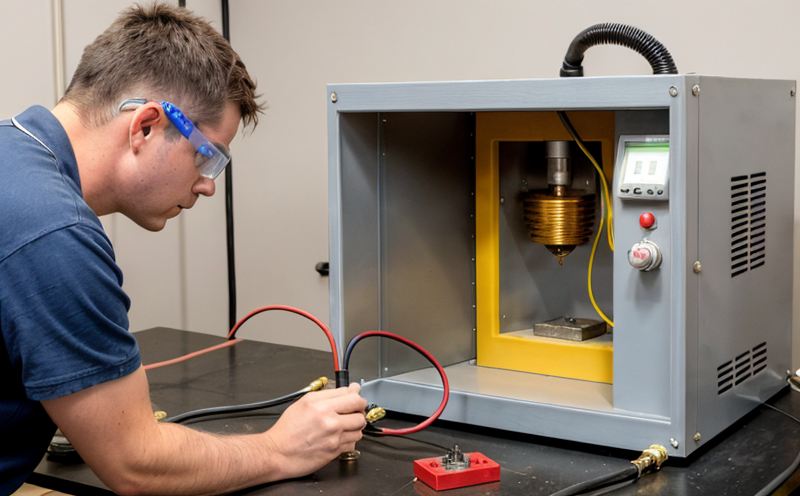ISO 4951 Electrical Resistivity of Metallic Conductors
The ISO 4951 standard is an internationally recognized protocol that specifies a method for determining the electrical resistivity of metallic conductors. This test is crucial in understanding the intrinsic properties of metals and their suitability for various applications, particularly those requiring high conductivity such as electrical wiring, electronic components, and thermal management systems.
The measurement of electrical resistivity is fundamental because it provides insights into the material's ability to conduct electricity. A lower resistivity indicates better conductivity, which can impact the performance and efficiency of metallic parts in different sectors including electronics, automotive, aerospace, and construction.
Metals such as copper, aluminum, silver, and gold are commonly tested using ISO 4951 due to their high electrical conductivity. However, this standard is not limited to these materials; it can be applied to any metallic conductor provided the specimen meets certain criteria for shape and size. The test procedure involves preparing a homogeneous sample of the metal in a specific form that ensures uniformity across the measurement area.
The testing process typically begins with selecting an appropriate sample, ensuring its dimensions comply with ISO 4951 guidelines. Once prepared, the sample is placed between two electrodes. A constant current is then passed through the sample while voltage measurements are taken at various points along its length. Using Ohm's law (V=IR), resistivity can be calculated based on these readings.
The accuracy of ISO 4951 results heavily depends upon precise specimen preparation and adherence to the standard’s detailed procedural steps. Non-uniformity in sample geometry or surface finish could lead to erroneous measurements, highlighting the importance of rigorous quality control throughout the testing process.
Understanding how electrical resistivity varies with temperature is also essential for accurate interpretation of ISO 4951 results. Metallic conductors exhibit a phenomenon known as thermal resistance where their resistivity increases slightly when heated above room temperature. This effect must be accounted for during measurements, especially in applications like heating elements or power transmission lines that operate at elevated temperatures.
ISO 4951 provides specific instructions on how to correct for these temperature effects, ensuring more reliable data across different environmental conditions. Additionally, the standard offers guidance on selecting appropriate electrodes and calibration techniques to minimize measurement errors further enhancing reliability.
In summary, ISO 4951 serves as a vital tool in evaluating metallic conductors’ electrical performance by providing standardized methods for measuring resistivity accurately. By employing this procedure consistently across industries, manufacturers can ensure that their products meet strict quality standards and perform reliably under diverse operational scenarios.
Why It Matters
The importance of ISO 4951 cannot be overstated in the metallurgy and material testing sector. This standard plays a pivotal role in ensuring that metallic conductors used across various industries adhere to high standards of quality and reliability. Here are some key reasons why ISO 4951 is critical:
Quality Control: By adhering to ISO 4951, manufacturers can maintain consistent product quality by verifying that each batch of metallic conductors meets specified electrical resistivity levels.
Regulatory Compliance: Many industries must comply with specific regulations regarding the materials they use. Ensuring compliance with standards like ISO 4951 helps avoid legal issues and maintains a good reputation among stakeholders.
Better Product Performance: Understanding electrical resistivity allows for optimizing product design to enhance performance, extend lifespan, or improve energy efficiency.
Cost Efficiency: Accurate measurement of resistivity can help identify substandard materials early in the production process, reducing waste and rework costs.
Innovation: ISO 4951 supports research and development efforts by providing a reliable benchmark for comparing new materials or processes against established benchmarks.
Eurolab Advantages
At Eurolab, we pride ourselves on offering comprehensive services that cater to the unique needs of our clients in the metallurgy and material testing sector. When it comes to ISO 4951 compliance, our advantages include:
Expertise: Our team comprises highly skilled professionals with extensive experience in performing electrical resistivity tests according to ISO 4951.
State-of-the-Art Equipment: We utilize advanced instrumentation designed specifically for precise and repeatable measurements of electrical properties, ensuring accurate results every time.
Comprehensive Reporting: Beyond just providing numerical values, our reports include detailed interpretations of the data, helping clients understand what the numbers mean in practical terms.
Timely Turnaround: We recognize the importance of timely delivery and strive to complete ISO 4951 tests within industry-recognized timelines without compromising on quality.
Customer Support: Our dedicated support team is always available to answer questions, provide guidance, or offer additional assistance whenever needed.
Quality and Reliability Assurance
At Eurolab, ensuring the highest levels of quality and reliability in our ISO 4951 testing services is paramount. We have implemented robust quality management systems to achieve this goal:
Dedicated Testing Facilities: Our laboratories are equipped with specialized environments that eliminate external factors affecting test results.
Regular Calibration: All instruments used in ISO 4951 tests undergo regular calibration checks to maintain accuracy and precision.
Trained Personnel: Only certified personnel perform the tests, ensuring adherence to international standards and best practices.
Continuous Improvement: We continuously strive to improve our processes through feedback from clients and staying abreast of advancements in testing methodologies.





